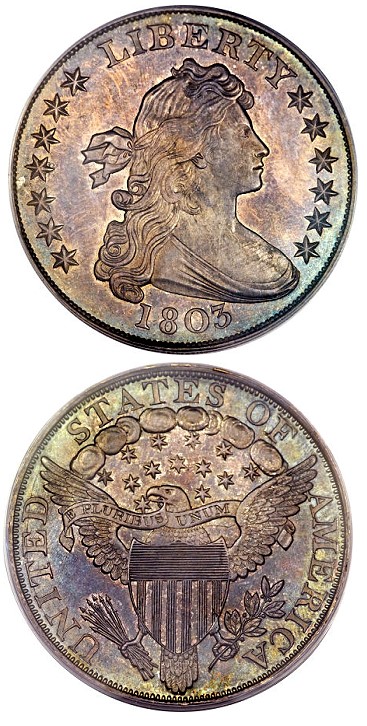Important proof coinage with focus on large cents and half dollars, other rarities expected to lead Jan. 9-13 event in Orlando, Fla.
ORLANDO – An 1803 “novodel” Bust dollar, PR66 PCGS, one of only four known to exist, is among the most noteworthy lots in Heritage’s U.S. Coin Signature® auction, part of the Official Auctions of the Florida United Numismatists convention, Jan. 9-13 in Orlando.
“Our January auctions in association with FUN have been an annual tradition since 1996, and this year’s event proves our relationship is stronger than ever,” said Greg Rohan, President of Heritage Auctions. “For the first time, our Platinum Night™ session includes U.S. currency as well as coins, bringing the best of both categories together for one special session.”
 The Greensboro Collection, Part II continues Heritage’s offering of a major collection with a concentration on proof minor and silver coinage. Part I, focused on proof dimes and quarters, helped drive the company’s October U.S. Coins auction, the Official Auction of the ANA National Money ShowSM in Dallas, to a total of $23.1 million sold.
The Greensboro Collection, Part II continues Heritage’s offering of a major collection with a concentration on proof minor and silver coinage. Part I, focused on proof dimes and quarters, helped drive the company’s October U.S. Coins auction, the Official Auction of the ANA National Money ShowSM in Dallas, to a total of $23.1 million sold.
Part II of The Greensboro Collection, while focused on proof large cents and half dollars, also contains noteworthy rarities in other denominations such as the 1803 “novodel” silver dollar. With just four pieces struck, the issue is twice as rare as the legendary rarity dated one year later, the Class I or “Original” 1804 dollar. The Greensboro example is making only its second auction appearance in its known history.
Among the proof half dollars in The Greensboro Collection, Part II is an 1838-O Reeded Edge half dollar, PR64 Branch Mint PCGS, one of a handful of examples struck as “test coins” either in Philadelphia or New Orleans.
In the recently published monograph The Surprising History of the 1838-O Half Dollar, Heritage numismatists David Stone and Mark Van Winkle present evidence that the proof 1838-O half dollars were struck on two occasions, with Originals struck in early 1838 at the Philadelphia Mint to test the dies and Restrikes made in January 1839 at the New Orleans Mint to test a newly arrived coin press. The 1838-O half dollar is a major rarity that lends instant prestige to any collector who owns one.
A third Greensboro Part II rarity expected to generate headlines is a 1792 half disme, SP67 PCGS, the only example of the Judd-7 variety certified as a “Specimen.” In April 2006, Heritage auctioned this piece for more than $1.3 million, and the coin is primed to be one of only a handful of individual coins to be auctioned for over a million dollars on two separate occasions.
Hailing from the famed Virgil Brand and Floyd Starr collections, this 1792 half disme is a strong candidate for the first U.S. coin released under authority of the Mint Act of April 1792. It is an important piece of the nation’s coinage history.
Many important rarities come from collections beyond Greensboro. Another rarity from the early history of U.S. coinage is a 1793 Chain cent, AMERI. reverse, S-1, B-1 variety, AU53 PCGS. It represents the initial issue struck at the First U.S. Mint building in Philadelphia, which was still under construction when the 1792 half dismes were produced. This coin comes from The Wes Rasmussen Collection.
The John W. Adams Collection contains many historic medals. A major highlight is the unique Cecil Calvert Maryland Map Medal Betts-35 1643-44 Cecil Calvert Maryland Map Medal, a piece previously owned by legendary collector John Ford and described as “the first Indian Peace Medal,” a class of treaty medals that would take on great importance in later centuries.
A complete 1868 Aluminum Pattern Proof Set, PR63 – PR67 Cameo NGC, is a beautiful and extremely rare set of the official coin designs of 1868, struck in aluminum instead of the regular metals. Accompanying the set is the original velvet-lined morocco presentation case that housed the coins when they were produced at the Philadelphia Mint. The set comes from The Douglas Collection.
An 1876-CC twenty cent, MS65 PCGS is a celebrated rarity in the U.S. silver series. This is one of the finest-graded survivors out of only a dozen or so known. The twenty cent denomination was struck for only four years, the last two in proof format only, and the Carson City Mint’s output for 1876 was destroyed almost to a coin.
Gold and gold-related items have considerable representation in the auction as well. An 1879 Flowing Hair stella in gold, PR67 Cameo NGC, CAC, is the finest of several examples of the experimental trade coin with a face value of four dollars. An extremely high-grade example of a 1927-S double eagle, MS67 PCGS, CAC, a gold issue that saw mass melting during the Roosevelt Administration, is considered the finest coin known of the limited number of pieces that still exist.
Heritage Auctions is the largest auction house founded in the United States and the world’s third largest, with annual sales of more than $800 million, and 750,000+ online bidder members. For more information about Heritage Auctions, and to join and receive access to a complete record of prices realized, with full-color, enlargeable photos of each lot, please visit HA.com
Want to get the up-to-the-minute updates and breaking news stories about Heritage Auctions? Get them as they happen at: HA.com/Twitter; Facebook: HA.com/Facebook. To view a complete archive of Heritage press releases go to: HA.com/PR. To link to this press release on your blog or Website: HA.com/PR-2297.





Hi,
I have american old coin 1803 novedel silver dollar exactly the same in ur site or picture…,.
I want to know how the price now?
And how can I sale i my coin..,. In just in case the price it’s ok for me…
Thank u for reply……